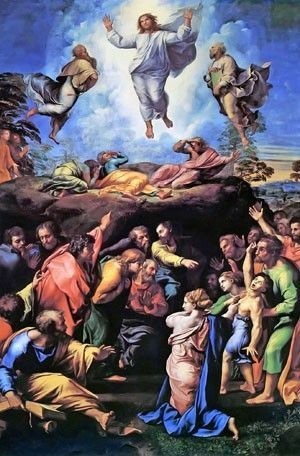Free |
RAPHAEL SANZIO | ||
Raphael Sanzio gallery of biblical paintings in high resolution, royalty free from our huge image library. Always Royalty Free |
Raphael 1483 – 1520 Work, unceasing work, filled the days of Raphael in Rome. The ingenuity and industry of the man were marvelous. Supplementing his monumental labors in the Palace of the Vatican and his architectural direction of St. Peter's, in succession to Bramante, more than eighty portraits were painted by him, besides designs innumerable for engravings, and even for silver and iron ornaments required by the Church. In addition to his work in the papal service, Raphael was also engaged in commissions for the wealthy banker Agostino Chigi, not only at his villa near Rome – now the Villa Farnesina – where the fresco of "The Triumph of Galatea" still adorns the wall, but in the Chigi family chapel in the Church of Santa Maria del Popolo, where he painted his famous Sibyls. His last important decorative work were the frescos painted in the Chigi, or Farnesina Palace, representing the mythological story of Cupid and Psyche. Vasari relates of this work that the great banker, having commissioned Raphael to decorate the first floor of his palace, was much disturbed because the painter was so slow setting to work. Even when he started on the frescos, "Raphael was so occupied with the love which he bore to the lady, that he could not give sufficient attention to the work. Agostino, therefore, falling at length into despair of seeing it finished, made so many efforts by means of friends and of his own, prevailed on the lady to take up her abode in his house. She was accordingly installed in apartments near those where Raphael was painting, and the work was ultimately brought to a conclusion." In two sonnets to this woman, who seems to have been the love of his life, Raphael addresses her as one far above him, vowing that he will never reveal her name. It is true that a marriage with the niece of his close friend Cardinal Bibbiena was once arranged for, the date of the wedding set and the Pope was to perform the ceremony. But Leo X regarded Raphael as a servant of the Church: he had work for him to do, and moreover, he had fixed ideas concerning the glamour of sentimentalism, so he requested that the wedding be postponed from time to time, and meanwhile the lady died. Raphael, in addition to decorating the Chigi Palace, was zealous in the papal service of unearthing and preserving the art treasures which lay buried under the ruins of Rome, and "with a princely magnificence sent artists through Italy and Greece to make drawings of those antiquities which he was unable to see himself. He was in intimate correspondence with most of the celebrated men of his time; interested himself in all that was going forward; mingled in society, lived in splendor and directed a host of pupils." His most famous easel-picture of "The Sistine Madonna" was painted, entirely by his own hand, a year before his death – the result of a fever contracted, some say, while superintending excavations in the malarial quarters of Rome, or, according to others, of a chill gotten while awaiting an audience with the Pope in one of the halls of the Vatican. The dying Raphael sent for his old master Perugino, directed that he should complete certain unfinished work, and expired at thirty-seven. Navigation and Searching – Terms of Use – Contact Us |
